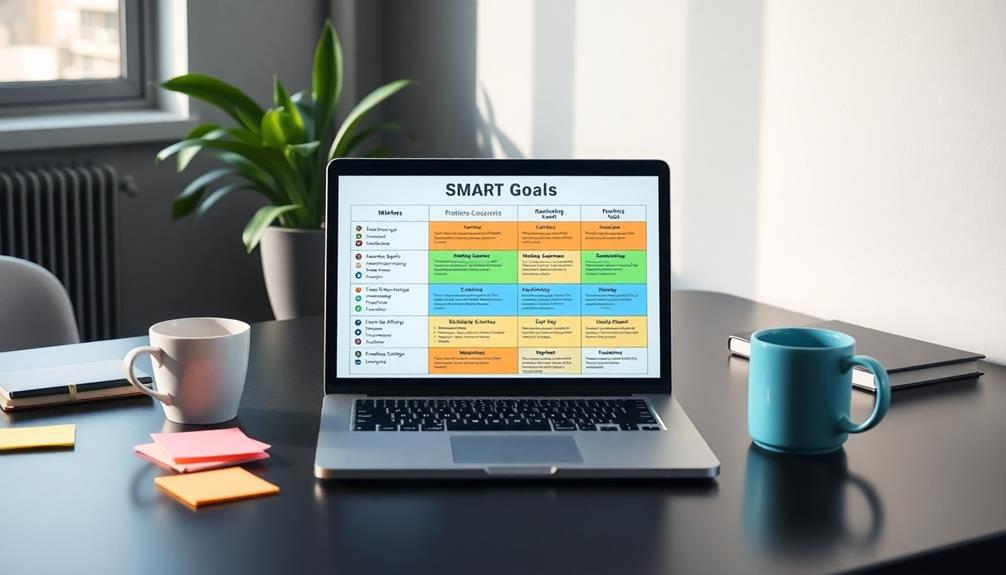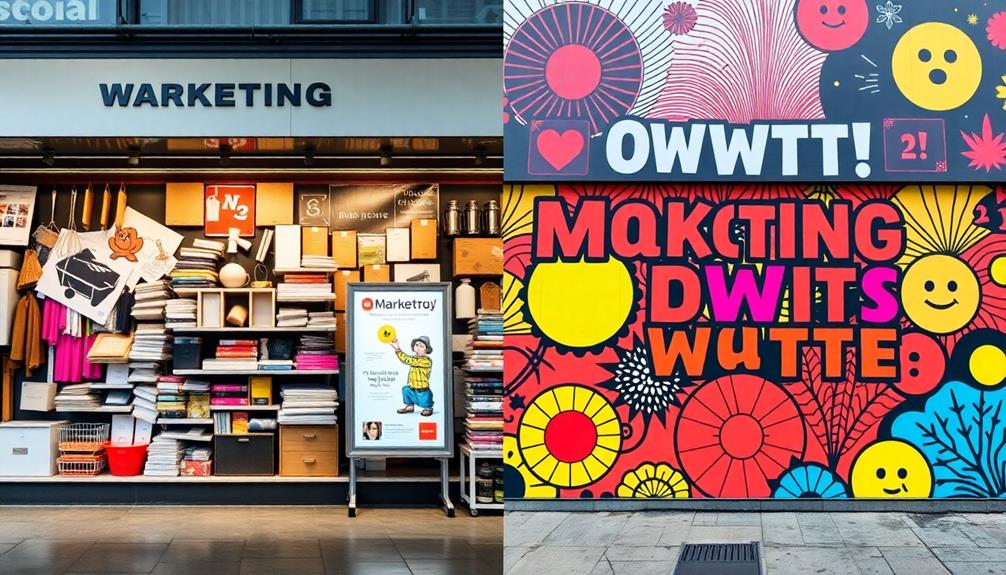To optimize your Facebook ad campaigns, use these eight AI prompts: draft compelling ad copy that speaks to your audience, generate creative campaign ideas that tap into current trends, and build a swipe file to inspire your content. Analyze target audiences for better segmentation, conduct competitive analysis to refine your messaging, and create clear briefs for designers. Summarize your data and insights for actionable strategies, and optimize performance metrics through A/B testing. Implementing these prompts can elevate your campaign effectiveness and boost engagement, leading to a more successful strategy overall. There's even more to explore for maximum impact!
Key Takeaways
- Utilize AI to analyze audience data and develop detailed buyer personas for targeted ad campaigns.
- Implement A/B testing through AI to refine ad creatives and copy for better engagement and conversion rates.
- Leverage AI-driven insights to identify emotional triggers that resonate with your target audience, enhancing ad effectiveness.
- Automate performance tracking with AI to quickly spot underperforming ads and optimize budget allocation in real-time.
- Use AI to generate compelling ad copy that highlights unique selling propositions and creates a sense of urgency.
Draft Compelling Ad Copy
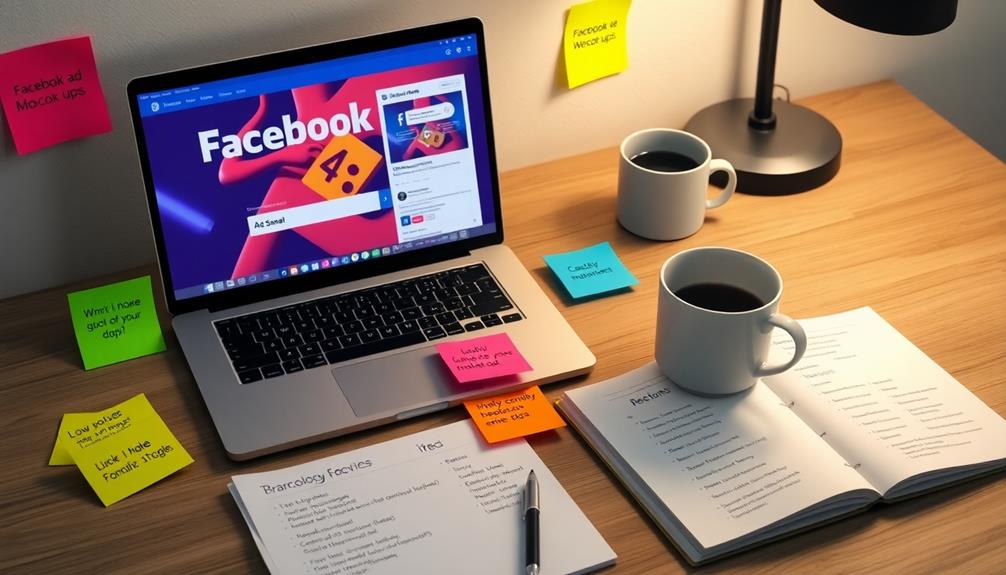
Crafting compelling ad copy is vital for capturing your audience's attention and driving conversions. To create engaging Facebook ad copy, you need to start by understanding your target audience and developing a customer persona. This guarantees your copy speaks directly to their needs and desires.
Highlighting your unique selling propositions (USPs) is essential, as it differentiates your product and attracts interest. Utilizing tailored prompts can help generate multiple variations of ad copy, allowing you to select the most effective options.
Don't forget to incorporate elements of urgency and special offers, especially during seasonal promotions or product launches, as these can greatly boost click-through rates.
Continuous testing is key to refining your ad copy. By analyzing performance metrics, you can make data-driven adjustments that enhance your messaging strategy. This iterative process not only improves your ad copy but also aligns it more closely with your audience's preferences.
Generate Creative Campaign Ideas

Once you've nailed down compelling ad copy, the next step is generating creative campaign ideas that truly resonate with your audience.
Utilizing tools like ChatGPT can help you brainstorm innovative concepts aligned with your brand objectives and audience targeting.
Additionally, focusing on high-quality content can enhance user engagement and retention, making your campaigns more effective.
Here are some ideas to inspire your Facebook advertising:
- Leverage seasonal themes: Craft campaigns around holidays or events to tap into timely emotions and drive engagement.
- Encourage user-generated content: Invite your audience to share their experiences with your brand, fostering authenticity and community.
- Run promotions or contests: Create excitement and incentive for participation, making your audience feel involved and valued.
- Explore collaborative campaigns: Partner with complementary brands to create unique offerings that benefit both parties and expand your reach.
Build a Swipe File
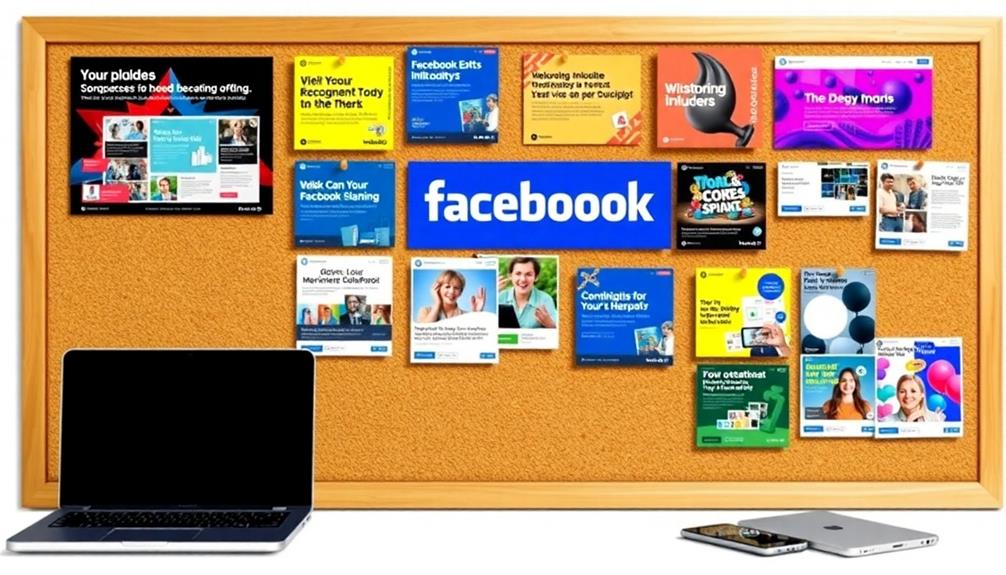
Creating a swipe file can be a game-changer for your Facebook ad campaigns. A swipe file is a curated collection of ad creatives that inspires and streamlines your creative process. By gathering successful ads, you can identify trends and best practices that enhance your campaign strategy.
Here's a simple table to help you organize your swipe file:
| Brand | Ad Type | Key Takeaway |
|---|---|---|
| Brand A | Video | Strong emotional appeal |
| Brand B | Carousel | Engaging storytelling |
| Brand C | Static Image | Clear call-to-action |
| Brand D | Collection | Showcase product range |
Regularly updating your swipe file with fresh examples keeps your creative process lively and allows for continuous improvement in performance data. Utilizing tools like ChatGPT can help you request specific attributes, enhancing the relevance of your swipe file. When you analyze successful ads, you can draw inspiration that aligns with your brand's voice, making your campaigns not just effective but also uniquely yours. Start building your swipe file today, and watch your ad effectiveness soar!
Analyze Target Audiences

Understanding your target audience is essential for the success of your Facebook ad campaigns. By analyzing target audiences, you can create detailed buyer personas that reflect demographics, interests, pain points, and goals. This approach informs your ad strategies and enhances ad performance.
Utilizing data analytics for targeted advertising can further refine your understanding of audience preferences and behaviors. To effectively reach your audience, consider these emotional triggers:
- Frustration over unmet needs
- Desire for solutions that simplify life
- Belonging to a community that shares values
- Ambition to achieve personal or professional goals
Utilizing AI can help uncover hidden patterns in customer data, revealing non-obvious characteristics that predict customer lifetime value.
Conduct Competitive Analysis

To boost your Facebook ad campaigns, it's essential to understand your competitors' strategies. By identifying their unique selling points and evaluating how their target audiences differ from yours, you can sharpen your own messaging.
This competitive analysis not only highlights opportunities but also helps you stand out in a crowded market. Additionally, leveraging insights from entrepreneurial mindset can empower you to innovate and refine your approach based on what resonates with your audience.
Understand Competitor Strategies
Evaluating competitor strategies is essential for any successful Facebook ad campaign. Conducting a thorough competitive analysis helps you uncover valuable insights into their advertising strategies, including messaging, targeting, and creative elements.
By examining ad performance metrics like engagement rates and conversion rates, you can identify effective tactics to adopt or enhance in your campaigns.
Consider these key areas when analyzing your competitors:
- Emotional appeals: What psychological triggers do they use to connect with their audience?
- Unique selling propositions: Are there aspects of their offers that stand out?
- Market dynamics: How do their strategies shift in response to changing trends?
- Creative elements: What visuals or formats capture attention?
Identify Unique Selling Points
Identifying unique selling points (USPs) is essential for differentiating your brand in a crowded marketplace. By conducting a competitive analysis, you can evaluate your competitors' strengths and weaknesses in their ad copy, messaging, and target audience strategies. This analysis helps you pinpoint areas where your offerings can shine.
Pay attention to the emotional appeals and psychological triggers used by your competitors. These insights reveal effective tactics that resonate with audiences, guiding you in crafting compelling ad content that stands out.
By comparing performance metrics of competitors' ads, you can identify market gaps and opportunities for differentiation through unique features or benefits. Refining your advertising strategies based on these insights guarantees your messaging highlights your distinct advantages over competitors.
Regularly updating your competitive analysis keeps you informed about industry trends, allowing you to adapt your USPs in response to evolving market conditions.
Ultimately, identifying your unique selling points through competitive analysis empowers you to create targeted ad copy that not only attracts attention but also drives conversions. Emphasizing what sets your brand apart is key to successful market differentiation.
Assess Target Audience Differences
Understanding target audience differences is essential for refining your Facebook ad campaigns. By conducting a competitive analysis, you can gain valuable insights into your competitors' messaging and strategies. This allows you to craft ad copy tailored to your unique selling points while also addressing the emotional appeals that resonate with your target audience.
Here are a few key aspects to examine:
- Discover what emotional triggers your competitors are using.
- Analyze the demographics and interests they target.
- Evaluate their performance metrics, like engagement and conversion rates.
- Identify gaps in audience segmentation that you can capitalize on.
Create Briefs for Designers

When creating briefs for designers, using ChatGPT can streamline your communication and guarantee everyone's on the same page. This tool helps you clearly define campaign objectives, target audience, and brand voice, making certain designers understand the project goals.
By utilizing structured templates, you enhance consistency and clarity, making it easier for designers to grasp the creative direction.
It's vital to include specific parameters in your briefs, such as color schemes, imagery, and messaging tone. This leads to more focused and relevant design outputs that align with your vision.
ChatGPT can also reference previous ideas and campaign elements, maintaining continuity and helping designers connect their work with established concepts and themes.
Incorporating feedback loops within the brief creation process allows designers to refine their work based on evolving campaign strategies and performance metrics. This ongoing dialogue guarantees that the final design outputs not only meet your expectations but also resonate with your audience.
Summarize Data and Insights
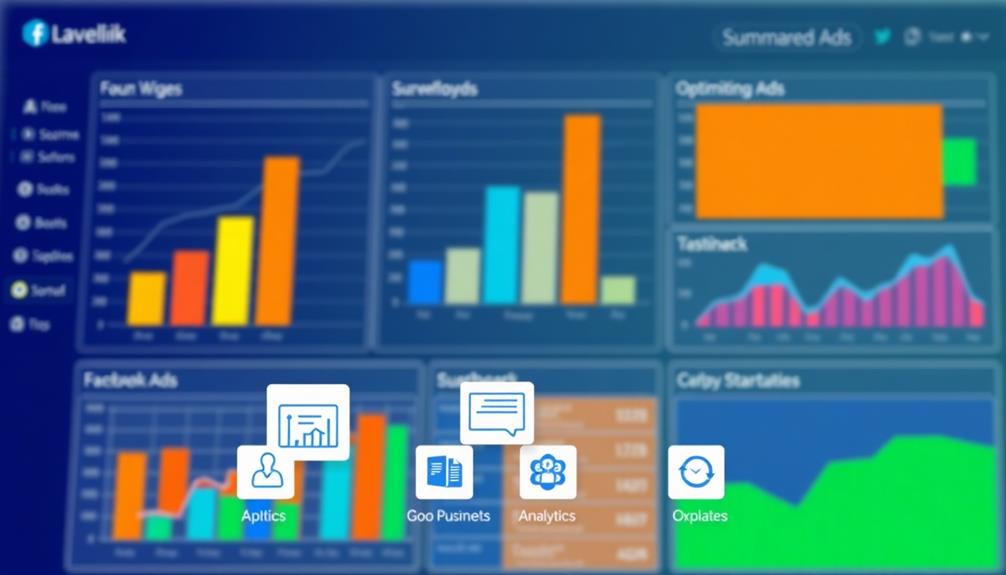
After setting clear briefs for your designers, it's time to leverage AI for summarizing data and insights from your Facebook ad campaigns.
With AI's data analysis capabilities, you can quickly distill large sets of ad account data into actionable insights. This helps you make informed decisions about ad performance and optimization.
Consider these benefits of AI in summarizing your campaign data:
- Identify successful strategies that drive conversions.
- Spot underperforming ads to refine your targeting.
- Adjust budget allocation based on real-time performance.
- Enhance campaign management with continuous feedback loops.
Optimize Ad Performance Metrics
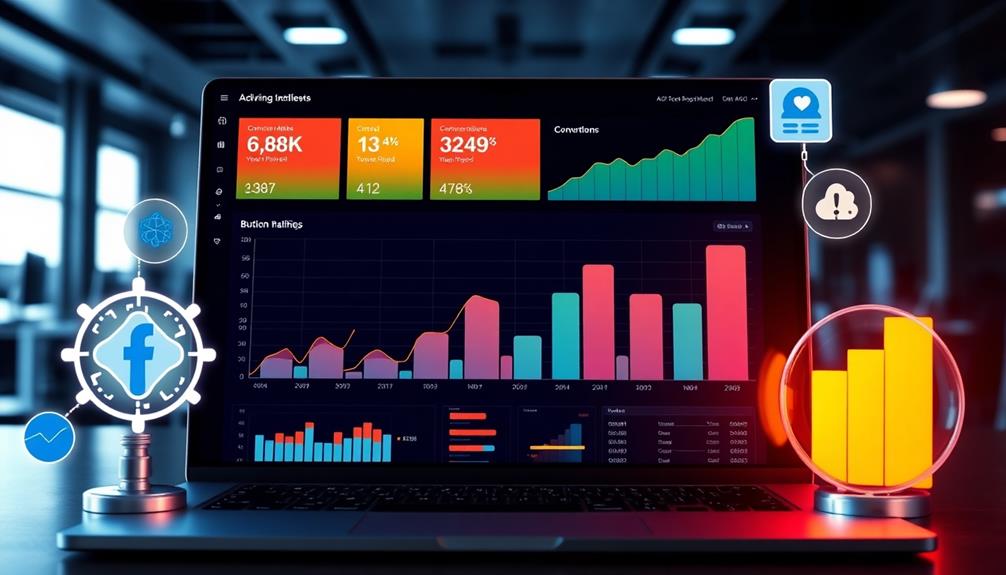
To optimize your ad performance metrics, focus on key performance indicators that matter most to your goals.
Analyzing engagement rates will help you understand how your audience interacts with your content, while conversion rate optimization can boost your overall results.
Key Performance Indicators
Understanding the key performance indicators (KPIs) for your Facebook ad campaigns is essential for optimizing their success. By focusing on critical metrics, you can guarantee your efforts lead to high-converting Facebook ads.
Here are some KPIs you should monitor:
- Click-Through Rate (CTR): This shows how many users click your ad after seeing it, with industry averages between 0.5% and 1.5%.
- Conversion Rate (CVR): This metric tells you how effectively your ads turn clicks into desired actions, with successful campaigns achieving rates of 2% to 5%.
- Cost Per Click (CPC): Knowing your CPC, which typically ranges from $0.50 to $3.00, helps you assess your ad spend.
- Return on Ad Spend (ROAS): Aim for a ROAS of at least 4:1 to guarantee profitability from your digital marketing efforts.
Another important metric is Frequency, which measures how often users see your ad. Keeping this between 1 and 3 is ideal to avoid ad fatigue.
Analyzing Engagement Rates
Engagement rates play a pivotal role in evaluating how well your Facebook ad campaigns connect with your audience. With benchmark rates typically ranging from 0.5% to 1.5%, understanding where your ads stand helps you gauge their effectiveness. High engagement rates, especially those above 1%, often lead to improved click-through rates and overall conversions.
To maximize engagement, analyze your metrics by audience segments. This analysis reveals which groups resonate most with your ad creatives, allowing for more targeted campaigns. Implementing A/B testing on different ad elements—like headlines and images—can greatly boost engagement rates. In fact, optimized creatives can enhance engagement by up to 30%, showcasing the power of strategic adjustments.
Keep an eye on your engagement metrics over time. Monitoring these trends helps you identify patterns that can inform your ad performance strategies. By being proactive and adjusting your targeting campaigns based on engagement insights, you can fine-tune your approach and achieve better results.
Ultimately, focusing on engagement rates empowers you to connect more effectively with your audience and enhance the impact of your Facebook ad campaigns.
Conversion Rate Optimization
Conversion rate optimization (CRO) is essential for maximizing the effectiveness of your Facebook ad campaigns. By improving the percentage of visitors who take desired actions, you can greatly boost your results.
Here are some strategies to help you on this journey:
- A/B Testing: Experiment with different ad creatives and copy to see what resonates best with your audience.
- Dynamic Creative Optimization: Test multiple ad components simultaneously to deliver personalized content that engages users.
- Performance Metrics Analysis: Regularly check click-through rates (CTR) and bounce rates to refine your ad strategies.
- Targeting Parameters Adjustments: Use audience insights to fine-tune who sees your ads, ensuring you reach the most relevant demographics.
To achieve effective conversion rate optimization, you need to be proactive. By leveraging A/B testing and dynamic creative optimization, you'll enhance your ad's appeal.
Additionally, keeping a close eye on performance metrics will help you align your content with user expectations. Remember, the right targeting parameters can make all the difference in converting clicks into actions.
Take these steps, and watch your Facebook ad campaigns thrive!
Frequently Asked Questions
How Do I Optimize My Facebook Ad Campaign?
To optimize your Facebook ad campaign, analyze audience behavior, test different ad elements, refine targeting, adjust budgets based on performance, and monitor competitors' strategies. This approach helps enhance engagement and improve conversion rates effectively.
Can You Use AI for Facebook Ads?
They say, "Work smarter, not harder." You can use AI for Facebook ads to analyze data, generate compelling copy, and target audiences effectively. It'll save you time and enhance your campaign's overall performance.
How to Prompt Chatgpt to Write Facebook Ads?
To prompt ChatGPT for Facebook ads, you'll want to specify your brand, product features, target audience, and desired tone. Use structured formats and examples to guide it, ensuring relevant and engaging copy.
How to Boost Facebook Ads Effectively?
To boost your Facebook ads effectively, utilize AI-driven audience targeting, implement multivariate testing, regularly update your creatives, analyze data for insights, and craft compelling copy with strong calls-to-action. Stay engaged with your audience!
Conclusion
To boost your Facebook ad campaigns, embrace these eight AI prompts. Draft compelling ad copy, generate creative campaign ideas, and build a swipe file. Analyze target audiences, conduct competitive analysis, and create briefs for designers. Summarize data and insights, then optimize ad performance metrics. By leveraging these strategies, you'll enhance your creativity, sharpen your targeting, and drive better results. So, plunge into, tap into AI, and watch your campaigns soar to new heights!


